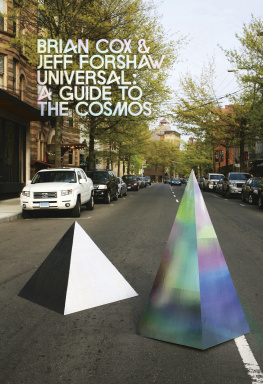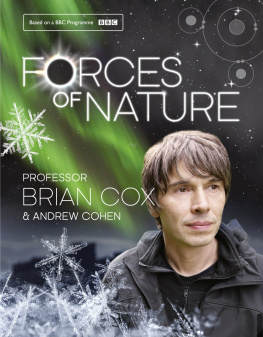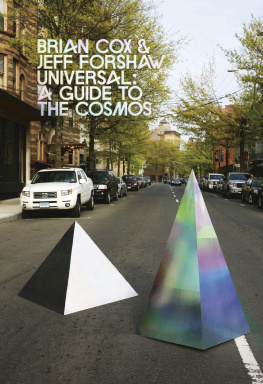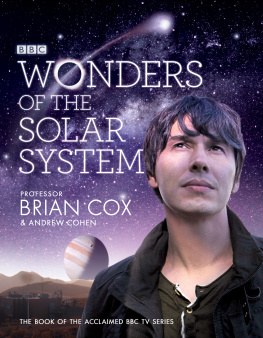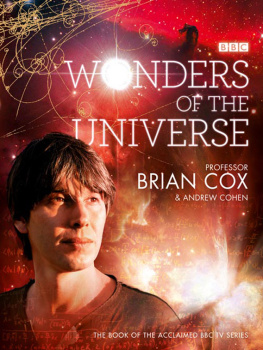ABOUT THE AUTHORS
Brian Cox OBE FRS is a Professor of Particle Physics at the University of Manchester and the Royal Society Professor for Public Engagement in Science. His many highly acclaimed BBC television documentaries include, most recently, Human Universe and Forces of Nature .
Jeff Forshaw is Professor of Theoretical Physics at the University of Manchester, specializing in the physics of elementary particles. He was awarded the Institute of Physics Maxwell Medal in 1999 for outstanding contributions to theoretical physics.
ABOUT THE BOOK
We dare to imagine a time before the Big Bang, when the entire Universe was compressed into a space smaller than an atom. And now, as Brian Cox and Jeff Forshaw show, we can do more than imagine: we can understand. Over the centuries, the human urge to discover has unlocked an incredible amount of knowledge. What it reveals to us is breathtaking.
UNIVERSAL takes us on an epic journey of scientific exploration and, in doing so, reveals how we can all understand some of the most fundamental questions about our Earth, Sun and solar system and the star-filled galaxies beyond. Some of these questions How big is our solar system? How fast is space expanding? can be answered from your back garden; the answers to others How big is the Universe? What is it made of? draw on the astonishing information now being gathered by teams of astronomers operating at the frontiers of the known Universe.
At the heart of all these questions from the earliest attempts to quantify gravity, to our efforts to understand what dark matter is and what really happened at the birth of our Universe is the scientific process. Science reveals a deeper beauty, connects us to each other, to our world, and to our Universe and, by understanding the groundbreaking work of others, reaches out into the unknown. Whats more, as UNIVERSAL shows us, if we dare to imagine, we can all do it.
ACKNOWLEDGEMENTS
For their specific help with various parts of the book, wed like to thank Richard Battye, Sarah Bridle, Mike Bowman, Bill & Pauline Chamberlain, Ed Copeland, Mrinal Dasgupta, Neal Jackson, Scott Kay, Kevin Kilburn, Peter Millington, Tim OBrien, Michael Oates, Subir Sarkar, Bob Seymour and Martin Yates. Particular thanks go to Mike Seymour, with whom we have had many enjoyable and helpful discussions.
Special thanks are also due to the team at Penguin and especially Tom Penn, our editor, and Tom Etherington, who produced the figures.
Thanks also to Diane and Sue for their continued guidance and support.
Finally, we would like to thank Peter Saville for his influence on the book, which extends beyond the beautiful cover design.
This book has been a long time in the making and we are deeply grateful for the support and encouragement of our families.
APPENDIX
The following is a list of some basic maths and physics that may be helpful.
POWERS OF 10
In cosmology and particle physics we often encounter numbers that are either very big or very small. To help write such numbers we use exponential notation. For example, 1 million, which is equal to 1,000,000, can be written 106. This should be read as 10 to the power of 6, which means it is equal to 10 multiplied by itself 6 times. Tiny numbers are written with negative powers, so one billionth, which is equal to 1/1,000,000,000 = 0.000000001, is written 109.
UNITS
Very often we deal with quantities that carry units. The simplest example might be a distance, such as 1 kilometre = 0.621 miles. As in the case of kilometres and miles, we always have the freedom to choose the units we want to use to measure something. Although metres and kilometres are convenient units for stating the typical distances we encounter in our daily lives, they are not very convenient in cosmology and particle physics. More commonly we will want to use light years, megaparsecs, ngstroms and nanometres. These can all be converted into metres as follows:
1 light year = 9.46 1015 metres
1 megaparsec = 1 Mpc = 3.26 106 light years
1 nanometre = 10 ngstroms = 109 metres
1 femtometre = 1015 metres
Likewise, in everyday circumstances it makes sense to measure energies in joules (e.g. a 20 watt light-bulb radiates energy at a rate of 20 joules per second), but when discussing particles of atom-size and smaller it makes more sense to use the electronvolt (denoted eV), which can be converted into joules using:
1 eV = 1.60 x 10-19 joules
We will often abbreviate units, e.g. 1 nm = 1 nanometre or 1 km = 1 kilometre or 1 mega-electronvolt = 1 MeV.
Numbers that carry with them an associated unit are called dimensionful numbers, and it is common to want to combine dimensionful numbers by multiplying or dividing them. The simplest example of this is when we take a distance and then divide it by a time in order to get something that is a speed. For example, a car moves 100 km in 2 hours, therefore its speed is 100 kilometres divided by 2 hours = 100 km/2 h = 100 1 km/2/(1 h) = 50 1 km/1 h = 50 km/h. Obviously you could see that the car moves at 50 km per hour straight away but we chose to show the various intermediate ways we could have written the ratio because simple manipulations like these are sometimes performed in the text.
We encounter two particularly elaborate dimensionful numbers in the book: the Gravitational constant, G = 6.67 m3/s2/kg and the Hubble constant, H = 68 km/s/Mpc. These units might look abstract, but in fact they are easy to comprehend. For example, divide G by a distance squared and then multiply it by a mass and you end up with a number with the units of acceleration (m/s2): if the distance is the radius of the Earth and the mass is the mass of the Earth, then the corresponding acceleration is the acceleration due to gravity, for an object dropped close to the Earths surface. Likewise, the units of the Hubble constant tell us that a galaxy 1 Mpc away recedes from the Earth at a speed of 68 km/s.
Occasionally we make use of elementary algebra. For example, the calculation of the speed of the car above could be carried out using the formula v = d / t where d = 100 km and t = 2 hours, to give v = 50 km/h. A formula can be transformed into another equally valid one by performing the same operation on each side of the equals sign, e.g. v t = vt = d / t t = d . In this case, we multiplied both sides of the equation by t to deliver an equation telling us that the distance d is equal to the product of the speed, v , and the time, t . Notice how we can write a product of two numbers either using an explicit multiplication symbol ( v t ) or, more simply, as v t . We always denote division by a backslash symbol (e.g. d / t t means d divided by t multiplied by t , which is simply equal to d ).
ELEMENTARY PARTICLES
Atoms are the building blocks of the ordinary matter we encounter on Earth. They are approximately an ngstrom across, and most of their mass resides in a tiny central nucleus built from protons and neutrons. Protons are only about 1 femtometre in diameter and they carry positive electric charge. Orbiting around the nucleus are the electrons, which carry negative electric charge such that the entire atom is neutral. The simplest atom is called hydrogen and it consists of a single proton and a single electron it is the most abundant type of atom in the Universe. The way that the electrons are arranged around the nucleus governs the way an atom interacts with other atoms, e.g. to produce molecules. The entire list of atoms can be collated in the .

